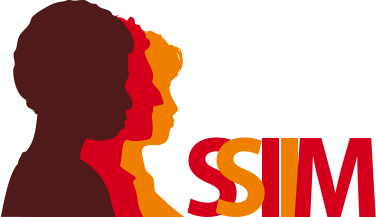INSigHT RESEARCH REPORTS
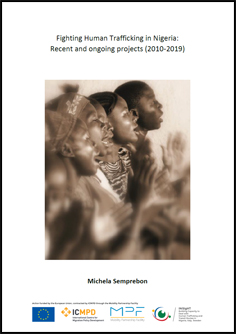
March 2020 >> GAP ANALYSIS REPORT “Fighting Human Trafficking in Nigeria: Recent and ongoing projects (2010-2019)” by Michela Semprebon
The purpose of this report is to analyse completed and ongoing anti-trafficking projects in Nigeria between 2011 and 2019 and to provide an overview that could be useful for stakeholders operating in the field, both in Nigeria and EU countries.
The geographical scope of the report includes Lagos and Edo State, but extends also over the wider Nigerian territory. The focus is on these project areas: awareness raising, capacity building for law enforcement, capacity building for rehabilitation and research. Moreover, a particular focus was on identifying projects targeted to female children and adopting a child- and women-sensitive approach, as well as projects involving some degree of transnational cooperation. The analysis concentrates on: total number of projects, donors, project leaders and partners, activities.
Download here
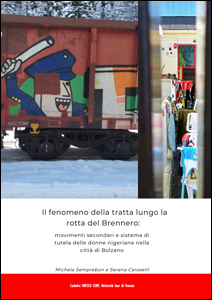 Marzo 2021 >> Il fenomeno della tratta lungo la rotta del Brennero: movimenti secondari e sistema di tutela delle donne nigeriane nella città di Bolzano, di Michela Semprebon e Serena Caroselli
Marzo 2021 >> Il fenomeno della tratta lungo la rotta del Brennero: movimenti secondari e sistema di tutela delle donne nigeriane nella città di Bolzano, di Michela Semprebon e Serena Caroselli
Questo e-book è dedicato al tema dei movimenti interni all’Europa e alla mobilità delle persone migranti vittime di tratta e grave sfruttamento nell’area compresa tra il confine italo-austriaco del Brennero e la città di Bolzano. Specifica attenzione è dedicata a questo contesto geografico e politico in quanto si caratterizza come luogo strategico, di transito verso il nord Europa e di rientro in Italia, dei e delle migranti coinvolti nel fenomeno del grave sfruttamento – sessuale e lavorativo – attraverso la rete nigeriana della tratta di esseri umani. La ricerca si è concentrata sull’esplorazione del contesto di accoglienza a Bolzano e sulle attività e azioni messe in campo o meno per tutelare le persone in transito attraverso il Brennero.
Scarica Qui >> il report Brennero (ITA)
***
July 2021 >> The phenomenon of trafficking along the Brenner route: secondary movements and the system of protection for Nigerian women in the city of Bolzano by Michela Semprebon & Serena Caroselli
This e-book is dedicated to the topic of intra-European secondary movements and the mobility of trafficked and seriously exploited migrants in the area between the Italian-Austrian border of Brenner and the city of Bozen. Specific attention is paid to this geographical and political context, as it is a strategic place of transit towards northern Europe and of return to Italy, for migrants involved in the phenomenon of serious – sexual and labour exploitation through the extensive Nigerian network of human trafficking. The research focused on the analysis of the reception activities in Bozen and the initativies put (or not) in place to deal with the needs of migrants in transit through the Brenner border.
Download here >> the Report on Brenner (ENG)
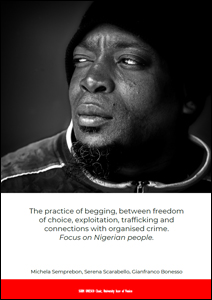
Marzo 2021 >> La pratica dell’accattonaggio, tra libertà di scelta, sfruttamento, tratta e connessioni con la criminalità organizzata. Focus sulle persone nigeriane di Michela Semprebon, Serena Scarabello, Gianfranco Bonesso
Questa pubblicazione si focalizza sull’accattonaggio da parte delle persone nigeriane in Italia e nell’area di Venezia. È frutto di un progetto di ricerca sperimentale condotto sul territorio veneziano ed in Italia, per approfondire un fenomeno ancora poco studiato e poco conosciuto: quello dell’accattonaggio. La letteratura mostra come il fenomeno sia molto complesso e non possa essere interpretato attraverso categorie rigide. E’ svolto principalmente da uomini ma anche da donne, tra cui donne sfruttate sessuamente. E’ collegato a condizioni di marginalità quindi può essere svolto in forme libere, ma anche semi-libere. Allo stesso tempo è talvolta associato a forme di sfruttamento e, in modo molto limitato, anche di tratta. Il fenomeno è analizzato nel più ampio contesto dello spazio urbano e delle politiche di sicurezza.
Scarica Qui >> il report Begging (ITA)
***
July 2021 >> The practice of begging, between freedom of choice, exploitation, trafficking and connections with organised crime. Focus on Nigeria people by Michela Semprebon, Serena Scarabello & Gianfranco Bonesso
This e-book explores the phenomenon of begging by Nigerian nationals in Italy and in the Venice area. Confirming what has been reported in the few studies on the subject, it stresses the multifaceted, multidimensional nature of the phenomenon that does not lend itself to being interpreted through rigid categories. Begging carried out by Nigerians involves mainly men, but also women, albeit to a lesser extent, including sexually exploited women. It can be associated to forms of free, semi-free begging but also begging connected to forms of exploitation and, to a very limited extent, trafficking. The phenomenon is analysed in the backdrop of urban public space and safety policies in Italy.
Download here >> report Begging (ENG)
***
May 2022 >> Begging in the north-eastern Italian Veneto Region – ADDENDUM to the report
This report was constructed on the materials collected and the exploratory research conducted during the Workshop ‘Mapping Urban Space and informal economies of begging’.
While the workshop was organised as an opportunity for students to benefit from the INSigHT Action research, it was also aimed to advance the research further and update the research findings collected in 2020. Thus this report costituite an advancement of the research report published in March 2021 (here above).
In particular, the workshop with students aimed at re-monitoring the field in Venice but also other territories in the Veneto Region and in a nearby Region where students live, which are all urban contexts known to be characterised by the phenomenon of begging and being at the crossroads of migrant flows. The Workshop included lectures and discussions with students aimed at providing students with an academic overview on informal urban economies, in particular concerning begging and its interconnections with urban policies on public space management and urban safety.
Download here >> the ADDENDUM to the report
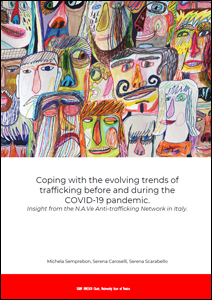 June 2021 >> Coping with the evolving trends of human trafficking in Italy before and during the COVID-19 pandemic. Insight from the N.A.Ve Network and from Nigerian women and girls by Michela Semprebon, Serena Scarabello & Serena Caroselli
June 2021 >> Coping with the evolving trends of human trafficking in Italy before and during the COVID-19 pandemic. Insight from the N.A.Ve Network and from Nigerian women and girls by Michela Semprebon, Serena Scarabello & Serena Caroselli
Anti-trafficking interventions in Italy have been undertaken for the past two decades. Many staff members of the N.A.Ve project, in the Veneto Region, on which this publication is focusing, have been engaging in anti-trafficking for more than a decade. Hence exploring N.A.Ve means investigating the strengths and weaknesses of the project, but also drawing from its long-term experience. Furthermore, exploring N.A.Ve gives us the opportunity to explore the most recent trends that have characterised the phenomenon of trafficking in Italy and the challenges faced by anti-trafficking projects overall with reference to different target groups, including increasing numbers of lone mothers with children, increasing evidence of labour exploitation and forced involvement in criminal activities, particularly of unaccompanied minors. In line with the objectives of the INSigHT Action, of which this publication is part, our main focus is on Nigerian women and girls. Various reports have been written over time regarding anti-trafficking systems in EU countries, with most attention been devoted to the normative framework and the differences across countries. Far less attention has been paid to how the actual systems work to grant the protection of people. This is the main objective of this e-book.
Download here >> report N.A.Ve (ENG)
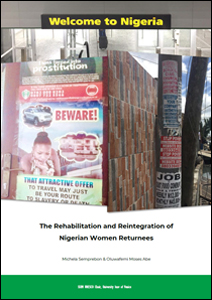 June 2021 >> The Rehabilitation and Reintegration of Women Returnees in Nigeria by Michela Semprebon & Oluwafemi Abe Moses
June 2021 >> The Rehabilitation and Reintegration of Women Returnees in Nigeria by Michela Semprebon & Oluwafemi Abe Moses
Nigeria, popularly referred to as the giant of Africa due to its large population – over 208 million – has long been known as playing a triple role as source, transit and destination country for girls, boys, women and men trafficked for the scope of sexual and labour exploitation. The focus of this publication is on Nigerian returnees victims of trafficking, especially for the scope of sexual exploitation. We look specifically at women and girls, who are still considered most vulnerable to human trafficking. We aim to provide a critical overview of the Nigerian system of rehabilitation and reintegration for people victims of human trafficking, particularly women and young girls. The main goals include the following: to provide evidence-based data to favour the understanding of how the anti-trafficking system functions in Nigeria and contribute to informed policymaking; to improve the capacity of stakeholders in Nigeria to implement effective measures against trafficking and the growing risk of re-trafficking, while also suggesting inputs for improved customised measures that should ultimately facilitate the access to services and the protection of people returnees.
Download here >> report Nigeria (ENG)
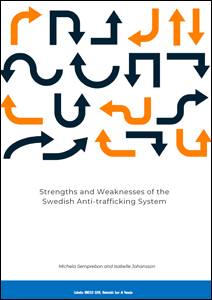 June 2021 >> Strengths and Weaknesses of Swedish Anti-trafficking System by Michela Semprebon & Isabelle Johansson
June 2021 >> Strengths and Weaknesses of Swedish Anti-trafficking System by Michela Semprebon & Isabelle Johansson
In regards to human trafficking, Sweden has been described as primarily a destination country and to a lesser extent a country of transit and origin. While it is unclear where the crimes against the trafficked individuals has been committed, some of the crimes have presumable taken place before their arrival to Sweden, some have regarded Sweden, although many experts still state that the number of victims and potential victims of trafficking in this country is very low. This publication explores the policy interventions undertaken to combat and prevent trafficking, with attention to the extent to which they also deal with the protection of women and children of Nigerian origin. Our reflections start from an overview of the policy framework to point out to what extent the anti-prostitution policy has contributed to develop what is generally known as the “Swedish model” – characterised by the criminalisation of clients. We suggest that this model has not contributed to fighting human trafficking and may have actually worked counter it. A particular focus is on how authorities have dealt with secondary movements from other European countries and to what extent they have resorted to the Dublin Regulation to return migrants, including also women victims of trafficking.
Download here >> report Sweden (ENG)
